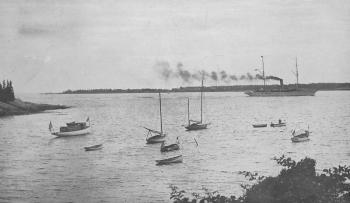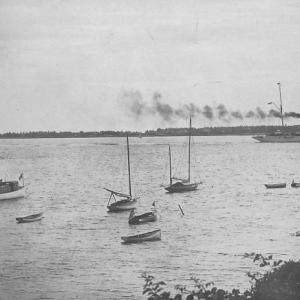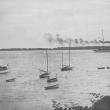Presidential Yacht Mayflower in Boothbay
The prior article covered the first three naval vessels that were used as presidential yachts ranging from about 300 feet to about 250 feet to 125 feet. Now we come to the fourth which ducked into Boothbay Harbor in summer 1910.
The 273-foot presidential yacht, Mayflower, was built in Scotland in 1896 for a wealthy American, Ogden Goelet, and was named for him. He lived in New York City and Newport, Rhode Island. The yacht’s luxurious qualities were meant to impress, with a crew of 150, marble bathtubs, and a dining room table for 30. But after only two years he became ill and sold it to the U. S. government in 1898.
Communications had greatly improved in the very early 1900s, so the U.S. government no longer felt it necessary to use vessels to convey information around the world. But there were still uses for a presidential yacht: to attend meetings along the eastern seaboard, to train sailors at sea while escaping very hot or cold weather, to entertain foreign and domestic dignitaries, deliver statesmen overseas, and allow presidents to escape public life occasionally.
Some of Mayflower’s Roles
One of Mayflower’s most notable roles was to serve as the setting in 1905 for President Theodore Roosevelt’s hosting the peace talks between Japan and Russia during the Russo-Japanese War. Roosevelt (terms 1901-1909) won the Nobel Peace Prize for his efforts. President William Taft served from 1909 to 1913, and it was during his term that the Mayflower visited Boothbay Harbor. President Woodrow Wilson (terms 1913-1921) reportedly wooed his second wife aboard the Mayflower, while President Calvin Coolidge (terms 1923-1929) stationed a chaplain aboard so he could cruise on Sunday without being accused of skipping church. President Herbert Hoover (term 1929-1933) had run on the government being more frugal about the visible perks, and he felt duty bound to decommission the Mayflower after his inauguration in 1929.
I wrote this article because volunteer Margaret Tew unearthed material online and in the historical society about the Maine coast visit of the presidential yacht, including a Bangor Daily News report and one of our postcards. The 1910 postcard pictured here shows the Mayflower under way somewhere along the Maine coast during President Taft’s 10-day trip to and from Bar Harbor in mid-July. It was sent on July 28, 1910 from here by Kate Reed, who lived in her and her sister Bess’s house on Oak Street, now the historical society, from their 1870s births. Of the two women, Bess (aka Betty) spent more time away, teaching in New York City for decades, but she was nearly always home for summers and extended holidays. In this case on July 28, 1910, Bess was visiting in Dublin, New Hampshire where she would have received the postcard.
The Postcard Message
Kate’s tongue-in-cheek postcard message to her sister was, My Dear Betty, with a magnifying glass you should be able to see the President on the Mayflower in Boothbay Harbor. I just happened to get out in time to see the yacht turn to go out the Eastern Sound. Much love, KLR. Taft had left Bar Harbor and was on his way south and eventually back to Washington.
We can only imagine what short but dramatic upheaval must have gone on in the Boothbay region during the fleeting yacht turn-around as close as the captain dared to come into the Harbor. The prior article mentioned that sizable naval vessels needed to have 40 feet of depth from the waterline. In Mayflower’s case, her depth was 32 feet—best to respect the 40-foot rule and stay out perhaps as far out as Squirrel.
Though the historical society has a fine collection of “Boothbay Registers,” (1876 to today) we are lacking in two or three decades — the worst decade is the 1910s. I went to surrounding historical societies and other entities over the years, hoping to find copies of any of the missing issues, but I had no luck with that issue. It’s always worth the try; other times I’ve succeeded. And I’ve checked online as the internet exploded in size over the years. But some things are just gone.
As a last peripheral aside about Kate . . . I spent many afternoons with Asa Tupper (born 1898) hearing about the old days. As a young man he worked at the Harbor post office for a summer job. Kate Reed worked there and supervised him. He remembers her as sharp, disciplined, and no-nonsense — intimidating. He feared the moment when it came to tying up the mail bags. Kate deftly made a complicated knot on each bag, but Asa couldn’t master it, particularly with Kate’s all-seeing critical eyes on him. Every day he worked she swiftly retied every one of his bags.

























